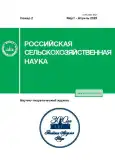Efficiency of organic carbon sequestration in typical slightly eroded chernozem
- Authors: Masyutenko N.P1, Kuznetsov A.V1, Masyutenko M.N1, Pankova T.I1, Breskina G.M1
-
Affiliations:
- Federal Agricultural Kursk Research Center
- Issue: No 2 (2023)
- Pages: 63-67
- Section: Articles
- URL: https://journals.rcsi.science/2500-2627/article/view/144607
- DOI: https://doi.org/10.31857/S2500262723020138
- EDN: https://elibrary.ru/AQHMAM
- ID: 144607
Cite item
Full Text
Abstract
About the authors
N. P Masyutenko
Federal Agricultural Kursk Research Center
Email: vninp@mail.ru
305021, Kursk, ul Karla Marksa, 70b
A. V Kuznetsov
Federal Agricultural Kursk Research Center305021, Kursk, ul Karla Marksa, 70b
M. N Masyutenko
Federal Agricultural Kursk Research Center305021, Kursk, ul Karla Marksa, 70b
T. I Pankova
Federal Agricultural Kursk Research Center305021, Kursk, ul Karla Marksa, 70b
G. M Breskina
Federal Agricultural Kursk Research Center305021, Kursk, ul Karla Marksa, 70b
References
- Дегумусирование и почвенная секвестрация гумуса / Б.М. Когут, В.М. Семёнов, З.С. Артемьева и др. // Агрохимия. 2021. № 5. С. 3-13. doi: 10.31857/ S0002188121050070.
- Aertsens J., De Nocker L., Gobin A. Valuing the carbon sequestration potential for European agriculture // Land Use Policy. 2013. No. 31. P. 584-594. doi: 10.1016/j.landusepol.2012.09.003.
- The knowns, known unknowns and unknowns of sequestration of soil organic carbon / U. Stockmann, M.A. Adams, J.W. Crawford,et al. // Agriculture, Ecosystems and Environment. 2013. Vol. 164. P. 80-99.
- Мониторинг основных агрохимических показателей плодородия пахотных почв в Центрально-Черноземном районе России / Р.В. Некрасов, С.В. Лукин, Д.А. Куницын др. // Достижения науки и техники АПК. 2021. Т. 35. № 9. С. 4-10.
- Влияние развития эрозионных процессов на содержание и запасы органического вещества, урожайность озимой пшеницы и разнотравно-злаковых ассоциаций, возделываемых на темнокаштановых почвах // В.А. Стукало, Т.Г. Зеленская, Е.Е. Степаненко и др. // Земледелие. 2021. № 4. С. 20-23.
- Качественный состав органического вещества дерново-подзолистой почвы в длительном полевом опыте // Р.Ф. Байбеков, К.П. Хайдуков, А.А. Коваленко и др. // Земледелие. 2020. № 1. С. 8-11
- Sanderman J., Hengl T., Fiske J.G. Soil carbon debt of 12,000 years of human land use // Proceedings of the National Academy of Sciences of the United States of America Proc. 2017. Vol. 114. P. 9575-9580. doi: 10.1073/pnas.1706103114.
- Влияние агробиотехнологий на запасы и состав органического вещества чернозема типичного слабоэродированного / Н.П. Масютенко, А.В. Кузнецов, М.Н. Масютенко и др. //Достижения науки и техники АПК. 2021. Т. 35. № 10. С. 45-50.
- Integrating plant litter quality, soil organic matter stabilization, and the carbon saturation concept / M.J. Castellano, K.E. Mueller, D.C. Olk, et al. // Global Change Biology. 2015. Vol. 21. No. 9. P. 3200-3209. doi: 10.1111/gcb.12982.
- Amundson R., Biardeau L. Soil carbon sequestration is an exclusive climate mitigation tool // Proceedings of the National Academy of Sciences of the United States of America Proc. 2018. Vol. 115. Nо. 46. P. 11652-11656.
- Soil Quality Refurbishment through Carbon Sequestration in Climate Change: A Review / V. Kumar, K. Sharma, V. Sharma, et al. // International Journal of Current Microbiology and Applied Sciences. 2017. Vol. 6. P. 1210-1223. doi: 10.20546/ijcmas.2017.605.131.
- Сафин Р.И., Валиев А.Р., Колесар В.А. Современное состояние и перспективы развития углеродного земледелия в Республике Татарстан // Вестник Казанского ГАУ. 2021. №3 (63). С. 7-13.
- Experimental consideration, treatments, and methods in determining soil organic carbon sequestration rates / K.R. Olson, M.M. Al-Kaisi, R. Lal, et al. // Soil Science Society of America Journal. 2014. Vol. 78. P. 348-360. doi: 10.2136/sssaj2013.09.0412.
- Агротехнологический потенциал управления органическим углеродом черноземов обыкновенных в зернопаропропашном севообороте / И.Т. Хусниев, В.А. Романенков, С.В. Пасько и др. // Российская сельскохозяйственная наука. 2022. № 3. С.38-44.
- Амиров М.Ф. Интенсивность усвоения углерода полевыми культурами в зависимости от технологии возделывания в условиях Республики Татарстан / Вестник Казанского ГАУ. 2021. №3 (63). С. 14-18
- Брескина Г.М., Чуян Н.А. Влияние приемов биологизации на урожайность сельскохозяйственных культур // Земледелие. 2020. № 3. С. 30-33.
- Регистр технологий возделывания зерновых культур для Центрального Черноземья / Г.Н. Черкасов, И.Г. Пыхтин, А.В. Гостев и др. Курск: ВНИИЗиЗПЭ РАСХН, 2013. 249 с.
- Регистр технологий возделывания масличных культур для Центрального Черноземья / Г.Н. Черкасов, И.Г. Пыхтин, А.В. Гостев и др. Курск: ВНИИЗиЗПЭ РАСХН. 2014. 179 с.
- Разложение растительных остатков и формирование активного органического вещества в почве инкубационных экспериментов / В.М. Семенов, Н.Б. Паутова, Т.Н. Лебедева и др. // Почвоведение. 2019. № 10. С. 1172-1184.
- Вадюнина А.Ф., Корчагина З.А. Методы исследования физических свойств почвы. М.: Агропромиздат. 1986. 416 с.
- Влияние биопрепаратов на почвенное органическое вещество, структурное и биологическое состояние чернозема типичного слабоэродированного: коллективная монография / Н.П. Масютенко, А.В. Кузнецов, Н.А. Чуян и др. Курск: ФГБНУ "Курский ФАНЦ", 2022. 217 с.
- Карпачевский Л.О. Пестрота почвенного покрова в лесном биогеоценозе. М.: Изд-во Моск. ун-та, 1977. 312 с.
- Мишустин Е.В., Востров И.П., Петрова А.Н. Методика определения целлюлозоразрушающей активности почвы. М.: Наука, 1987. 375 с.
Supplementary files









